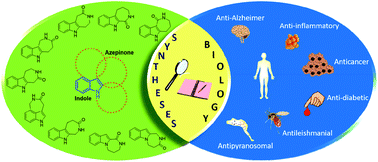Syntheses and medicinal chemistry of azepinoindolones: a look back to leap forward
Abstract
Nitrogen-containing heterocyclic scaffolds constitute nearly 75% of small molecules which favorably act as drug candidates. For the past few decades, numerous natural and synthetic indole-based scaffolds have been reported for their diverse pharmacological profiles. In particular, indole-fused azepines, termed azepinoindolones, have come under the radar of medicinal chemists owing to their synthetic and pharmacological importance. A plethora of literature reports has been generated thereof, which calls for the need for the compilation of information to understand their current status in drug discovery. Accumulating reports of evidence suggest that compounds containing this privileged scaffold display their cytotoxic effects via inhibition of kinase, topoisomerase I, mitochondrial malate dehydrogenase (mMDH), and tubulin polymerization and as DNA minor groove binding agents. Herein, we endeavor to present a closer look at the advancements of various synthetic and derivatization methods of azepinoindolone-based compounds. We have further extended our efforts to discuss the pharmacological effects of azepinoindolones in the whole range of medicinal chemistry as anti-Alzheimer, anticancer, anti-inflammatory, antidiabetic, antileishmanial, and antipyranosomal agents and as drug delivery vectors. Our analysis of recent advances reveals that azepinoindolones will continue to serve as potential pharmaceutical modalities in the years to come and their substantial pool of synthetic methods will be ever expanding.

- This article is part of the themed collection: Synthetic methodology in OBC


 Please wait while we load your content...
Please wait while we load your content...